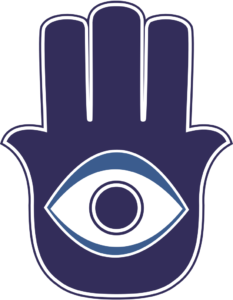What does the Hamsa Hand Symbol Mean?
The hamsa, is a charm in the shape a five-finger open palm right hand. It is used as a sign to offer peace, happiness, good fortune, luck, prosperity and is also used to ward off the evil eye.
The hamsa hand protects from harm caused by the evil eye of others.

Often the hand may contain an eye in the palm to highlight the hamsa’s ability to deflect the malicious eyes of others. The hamsa hand doesn’t need to have the eye in its center, as its meaning doesn’t change, it will still provide you with protection from the evil eye ,.
The hand can be depicted with the fingers spread apart to ward off evil, or as closed together to bring good luck.
The Hamsa Hand Represent
- Blessings
- Deflecting the evil eye
- Power and strength
- Good luck – patience, fidelity, fertility
The Hamsa in Judaism is also referred to as the Hand of Miriam, to represent the sister of Moses and Aaron. It also symbolizes the Hand of God, the five books of the Torah, and the fifth letter of the Hebrew alphabet, “Hey”, which is one of God’s holy names.
The hand symbol, and its association with the number five, reminds the owner of the Hamsa to use their five senses for power and strength. The number five is also associated with protection against the evil eye.
Other symbols or words can also appear within the Hamsa hand in addition to eye, for example a heart, astrological symbols and signs of the Zodiac (a person might buy a hamsa decorated with his or her personal sign) or the word Mazel (written in Hebrew or English) is sometimes inscribed on the amulet, the word ‘mazel’ means “luck” in Hebrew so it goes along with the luck theme of the hamsa hand for luck.
- Insert PICTURE of hamsa with the word “mazel” appear on the example above.)
Today the Hamsa is seen as a universal protective sign. While the hamsa has been interpreted by many scholars as jewish, the hamsa is also seen in multiple Islamic faiths, new age spiritualism and other ancient cultures.
The Hamsa is one of the most ubiquitous nondenominational motifs used in both religious and cultural contemporary art and design. The symbol is popular all over the world.
By wearing a hamsa or it being displayed within the home, one believes they can protect themselves from negative influences that are otherwise outside their control, while inviting good fortune.
Boost your chances for good energy and prosperity while warding off evil spirits of the evil eye.
